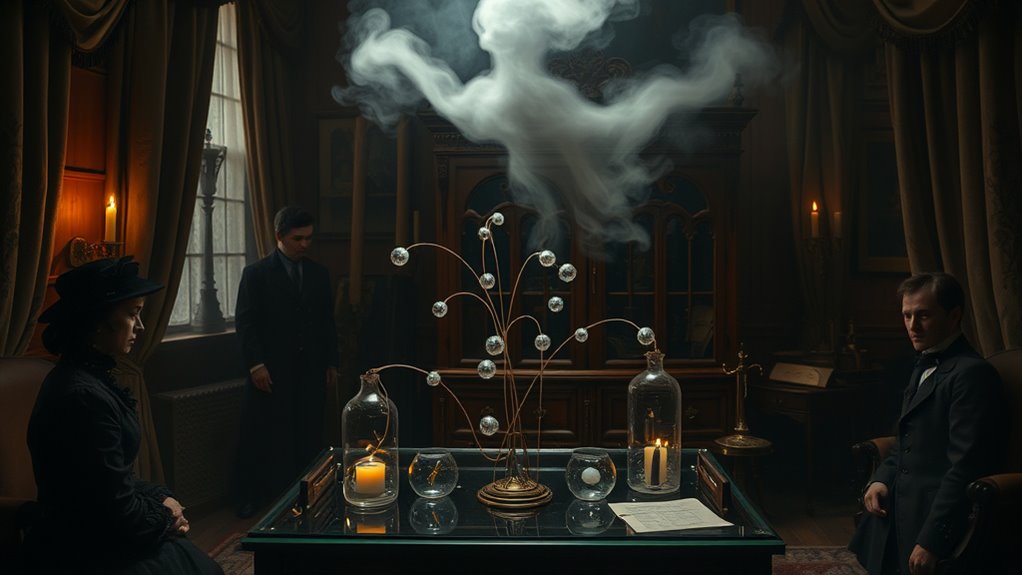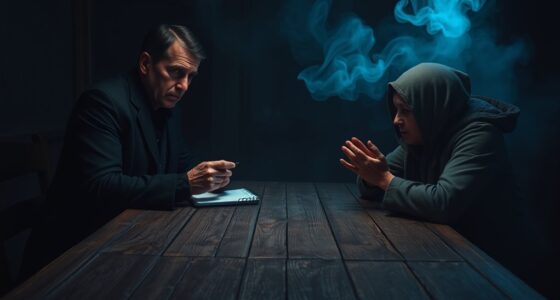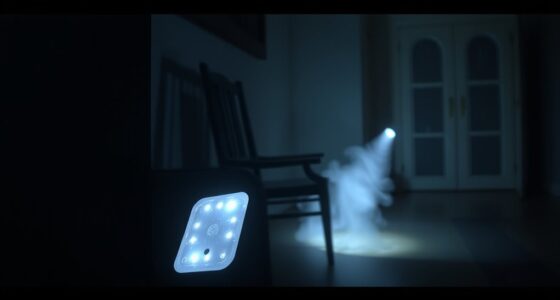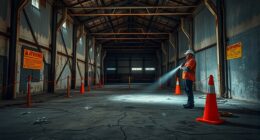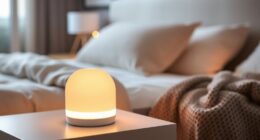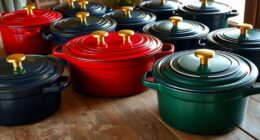To explore spirits scientifically, you set up controlled séance experiments by minimizing noise, distractions, and environmental factors that could lead to trickery. Using tools like EMF meters, infrared cameras, and audio recorders helps you gather tangible evidence, while strict protocols guard against illusions and bias. Understanding psychological influences like expectation and suggestion helps improve objectivity. If you want to discover how technology and methodology are shaping paranormal research, you’re in the right place.
Key Takeaways
- Controlled séance experiments minimize environmental variables like noise and light to ensure reliable testing of spirit communication.
- Use of measurement tools such as EMF meters, EVP recorders, and thermal cameras helps gather objective evidence.
- Ritual symbolism and standardized setups are employed to reduce psychological biases and prevent deception.
- Replication and calibration of experiments enhance validity and help distinguish genuine phenomena from tricks.
- Ethical protocols and awareness of illusion techniques are crucial for maintaining scientific rigor in spirit research.
Historical Perspectives on Séances and Scientific Inquiry

Historically, séances have fascinated both skeptics and believers, prompting scientific inquiry into their legitimacy. During the 19th and early 20th centuries, spiritual symbolism played a significant role in these practices, with mediums claiming to communicate with spirits through various signs and symbols. These historical séance practices often involved table tipping, automatic writing, and ghostly apparitions that seemed to confirm contact with the afterlife. Scientists and skeptics alike studied these phenomena, seeking natural explanations or evidence of supernatural activity. While some believed in genuine spiritual communication, others viewed these séances as elaborate tricks or psychological phenomena. This era laid the foundation for ongoing debates about the nature of spirits and the scientific investigation of paranormal claims.
Designing a Controlled Environment for Spirit Experiments
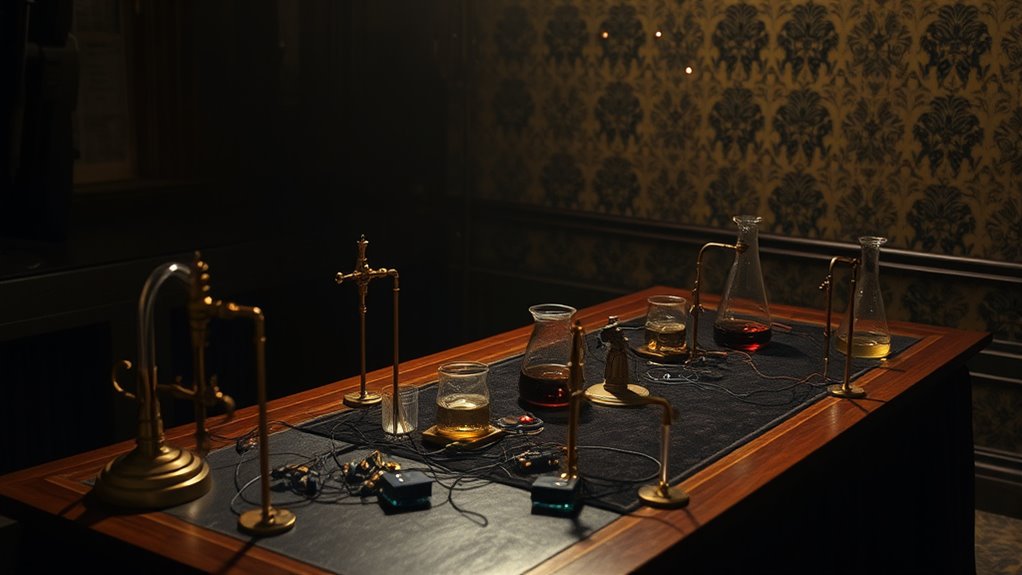
Creating a controlled environment is essential for conducting credible spirit experiments, as it helps eliminate external influences that could produce false or misleading results. To do this effectively, you need to minimize noise, drafts, and other environmental distractions. Use materials that block electromagnetic interference, which can affect sensitive equipment and obscure psychic phenomena. Incorporate ritual symbolism carefully, ensuring it doesn’t influence the experiment’s objectivity—avoid unnecessary ritualistic elements that could evoke psychological biases. Keep the setting simple and consistent, so any detected phenomena are more likely to be genuine. By controlling lighting, temperature, and sound, you create a stable space where spirits, if present, are less likely to be influenced by external variables. Implementing automation’s role in business intelligence can also help monitor and maintain environmental stability during experiments. Utilizing reliable measurement tools and data logging devices can further enhance experimental accuracy and help distinguish genuine phenomena from anomalies. Employing calibration techniques ensures that all equipment functions correctly, minimizing measurement errors and increasing confidence in your results. Additionally, regular calibration can help detect subtle deviations that might otherwise be overlooked, further enhancing experimental reliability. This disciplined approach enhances the reliability of your experiments and the validity of any psychic phenomena observed.
Common Methods and Techniques Used in Modern Spirit Testing
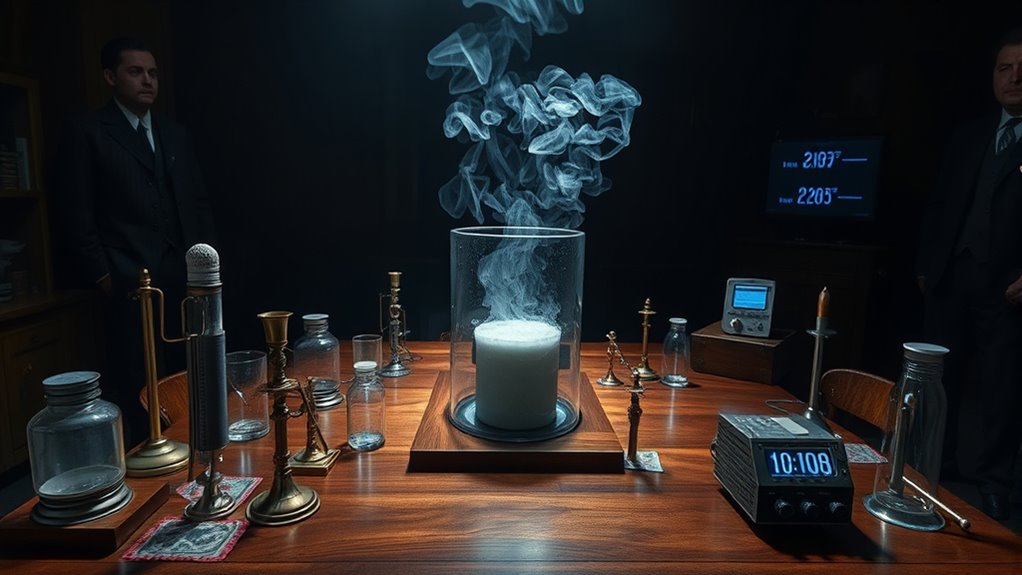
Modern spirit testing employs a variety of methods and techniques designed to detect, document, and interpret phenomena attributed to spirits. You might observe experiments focusing on psychic phenomena, where individuals claim to sense or communicate with spirits through clairvoyance or telepathy. Energy transfer is also a key concept; researchers look for signs that spirits can influence physical objects or generate detectable energy shifts. Instruments like electromagnetic field (EMF) meters measure fluctuations that could indicate spiritual activity. Some practitioners use spirit boxes or EVP (Electronic Voice Phenomena) recordings to capture voices or sounds beyond normal hearing. These techniques aim to gather tangible evidence, relying on subtle signals that suggest spirits interact through energy transfer or psychic phenomena. Additionally, understanding the underlying scientific principles can help differentiate between genuine phenomena and misinterpretations or artifacts. Exploring the role of technology can further enhance the reliability of these experiments by reducing subjective biases. Incorporating rigorous experimental controls is essential to distinguish authentic spirit activity from natural or environmental noise. Implementing standardized testing protocols can also improve the consistency and credibility of spirit investigations.
The Role of Technology in Detecting Unseen Phenomena

Technology plays a crucial role in detecting unseen phenomena by providing tools that extend our senses beyond the natural limits. You can now monitor for ghostly apparitions and spectral energies with advanced equipment.
- Infrared cameras capture thermal signatures linked to unseen entities.
- EMF meters detect fluctuations that may indicate spectral energies.
- Audio recorders pick up EVPs, revealing voices from beyond.
- UV and IR lights expose phenomena invisible to the naked eye.
- High-frequency sensors track subtle environmental changes associated with spirits.
- Modern vehicle tuning devices allow for precise calibration of equipment to improve sensitivity and accuracy in paranormal investigations. These devices help you observe phenomena that defy normal perception, offering scientific insights into ghostly apparitions. Additionally, the use of spectral analysis techniques can help differentiate genuine paranormal signals from background noise.
- Incorporating data logging capabilities enables continuous monitoring and detailed analysis of environmental variables, which can uncover patterns linked to paranormal activity.
- Employing control groups and replicated experiments further increases the reliability of findings in paranormal research.
In addition, utilizing advanced calibration techniques can enhance the precision of measurement tools. By integrating technology into experiments, you move closer to understanding whether unseen energies are truly present during paranormal activity.
Challenges in Differentiating Between Trickery and Genuine Activity
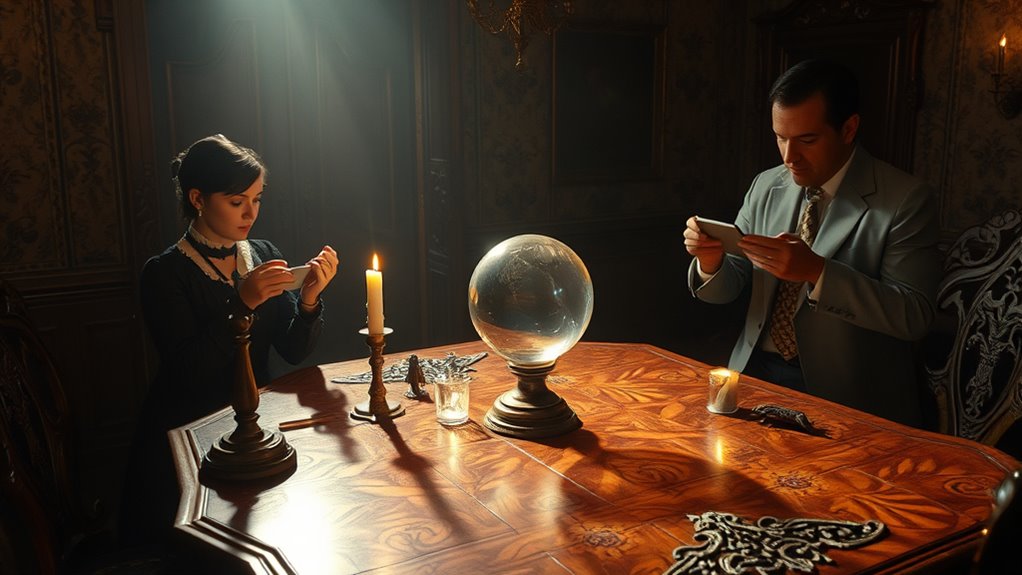
Distinguishing genuine paranormal activity from deliberate trickery remains one of the most significant challenges in séance room investigations. You must be vigilant, as optical illusions can easily deceive your senses, making trickery appear authentic. Sensory deprivation, intended to heighten perception, can sometimes cause misinterpretation of subtle movements or sounds. To better understand these challenges, consider this table:
| Trickery Technique | Sensory Deprivation Effect | Common Deception Method |
|---|---|---|
| Hidden mechanisms | Heightens illusion, confusion | Use of concealed devices |
| Optical illusions | Alters perception, misleads | Lighting tricks |
| Misdirection | Distracts from real activity | Audience manipulation |
| Sleight of hand | Creates false impressions | Quick hand movements |
| Sound manipulation | Fools auditory senses | Hidden speakers |
Recognizing these tactics helps you differentiate between genuine phenomena and trickery. Additionally, understanding payment security measures can inform how to safeguard sensitive information during investigations or related activities. Being aware of investigation protocols can further assist in maintaining objectivity and reducing the likelihood of being fooled. Developing a thorough understanding of illusion techniques can also aid in identifying and counteracting potential deception strategies.
Notable Experiments and Their Findings
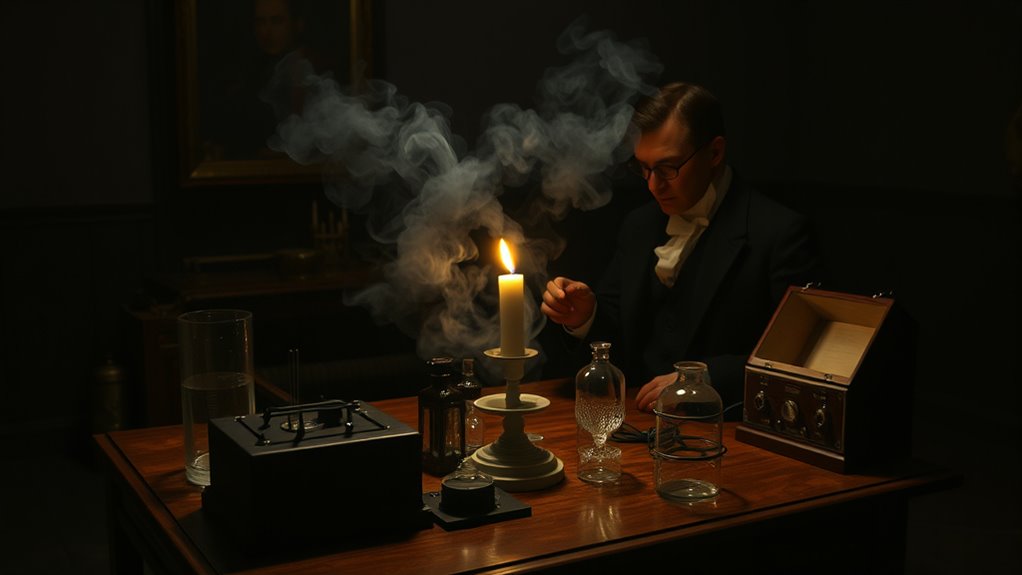
Several groundbreaking experiments have shaped our understanding of paranormal phenomena and tested their authenticity. These studies often focus on how spiritual symbolism and séance room design influence results. For example, researchers tested whether altering the layout affected spirit communication, with mixed outcomes.
Groundbreaking experiments reveal environment and symbolism influence paranormal experiences and spirit communication.
- The use of controlled lighting to minimize trickery
- Measuring responses to specific spiritual symbols
- Testing for physical anomalies in carefully designed rooms
- Analyzing the impact of room arrangement on séance outcomes
- Attempting to replicate phenomena through standardized setups
These experiments suggest that environment and symbolism play roles in perceived paranormal activity. While some results hint at genuine phenomena, others point to psychological influences or trickery. Overall, these findings deepen our understanding of how séance room design and symbolism may shape experiences.
The Influence of Expectation and Suggestion on Results

You might notice how your expectations can shape what you perceive during a séance, often without realizing it. The placebo effect shows that belief alone can produce real sensations or outcomes, even without any actual paranormal cause. Expectation bias further influences results, making it easier to see what you want to find rather than what’s truly there.
Power of Placebo Effect
The power of the placebo effect demonstrates how your expectations and suggestions can profoundly influence experimental outcomes. When you believe in a result, your mind can create real sensations or perceptions, even without actual evidence. Cultural influences can amplify this effect, shaping what you expect to see or feel. Mass psychosis also plays a role, where collective beliefs drive shared experiences. This means that your environment, societal norms, and group mentality can heighten the placebo response.
- Expectations set by cultural narratives shape what you anticipate during séances
- Collective beliefs can trigger mass psychosis, mimicking spiritual phenomena
- Suggestion influences your perception of spirits or paranormal activity
- Cultural context can make you more susceptible to placebo effects
- Group dynamics can reinforce false impressions, skewing results
Role of Expectation Bias
Have you ever noticed how your expectations can shape what you perceive during a séance? This is where expectation bias comes into play. Your beliefs about spirits or the séance process influence what you interpret as evidence, often leading you to see what you hope or expect to see. This effect is closely linked to the placebo effect, where your mind convinces you of something’s validity simply because you believe it’s real. Expectation bias can cause you to overlook natural explanations or dismiss ambiguous results. It’s a powerful psychological influence that skews perception, making it seem as though spirits are present when, in fact, your mind is filling in the gaps based on suggestions or prior beliefs. Recognizing this bias helps us better understand the limitations of subjective experiences in séance settings.
Case Studies of Successful and Contested Experiments
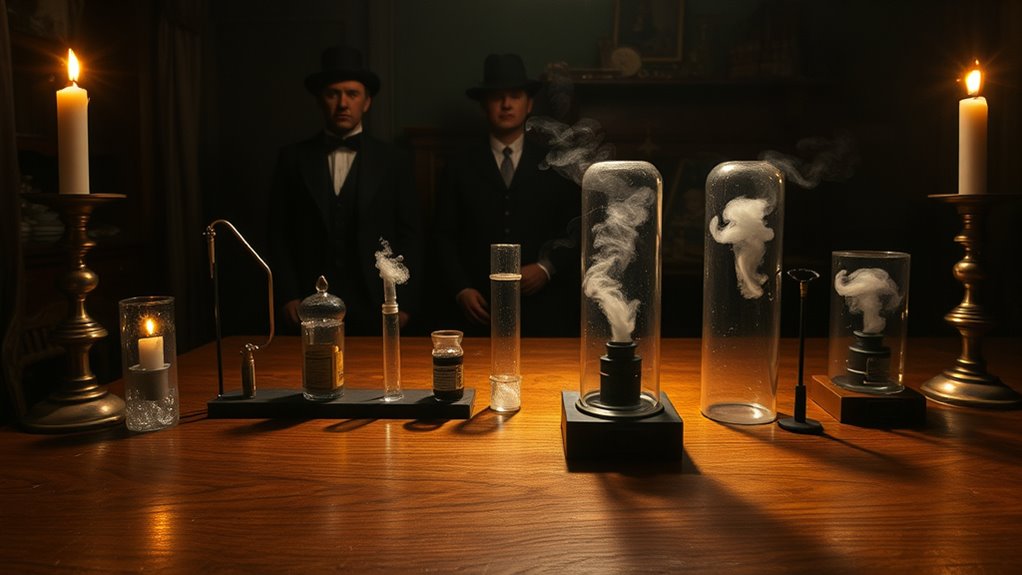
You’ll find that some experiments in séance research are celebrated for their compelling results, while others spark fierce debate. Exploring these case studies reveals the successes that challenge skeptics and the critiques that expose methodological flaws. Together, they highlight the challenges researchers face in producing reliable, convincing evidence.
Notable Experimental Successes
Among the most compelling cases in the history of séance research are experiments that yielded measurable, repeatable results, challenging skeptics and fueling ongoing debate. These successes often involve clear instances of psychic phenomena linked to ritual symbolism, making them harder to dismiss. For example, some researchers documented spirit voices that responded accurately to specific questions, suggesting a controlled communication channel. Others observed materializations that appeared during carefully monitored sessions, with physical evidence supporting their authenticity. These experiments typically featured strict controls, like verifying the identity of participants or eliminating external influences. While some results remain contested, these cases demonstrate that under certain conditions, spirits may produce observable, consistent phenomena that push the boundaries of scientific understanding.
- Spirit voices with accurate responses
- Materializations during controlled tests
- Use of ritual symbolism to invoke entities
- Repeatable phenomena across different experiments
- Rigorously documented, peer-reviewed findings
Controversial Results and Critiques
While some experiments in séance research have produced compelling, repeatable results, many studies remain mired in controversy and skepticism. Critics question whether outcomes are influenced by misinterpretation of spiritual symbolism or cultural interpretations. For example, certain signals attributed to spirits could be explained through natural causes or subconscious cues. Successful experiments often include clear controls, but contested cases highlight flaws like bias or inadequate blinding. The table below compares widely debated experiments:
| Experiment | Controversy | Cultural Influence | Outcome | Status |
|---|---|---|---|---|
| Rhine’s ESP séances | Alleged spirit communication, questioned validity | Cultural symbolism affected interpretation | Mixed results | Partially accepted |
| Gurney’s spirit photography | Possible trickery, inconsistent results | Cultural fascination with spiritual images | Disputed authenticity | Largely dismissed |
| Hyslop’s mediumship tests | Allegations of fraud, ambiguous data | Cultural beliefs shaped expectations | Contested | Skeptical consensus |
| Rhine’s card guessing test | Suspected cues, lack of replication | Cultural biases influenced responses | Reproducibility challenged | Limited acceptance |
| Hodgson’s automatic writing | Possible unconscious influence, subjective data | Cultural symbolism interpreted variably | Debated | Ongoing skepticism |
Methodological Challenges Faced
Methodological challenges considerably influence the outcomes of séance experiments, shaping both their successes and failures. Ensuring accurate sensor calibration is essential to detect subtle phenomena without false signals. Participant selection also plays a critical role; choosing individuals who are open-minded yet skeptical helps prevent bias. Contested experiments often struggle with controlling environmental variables, which can skew results. Additionally, maintaining strict protocols minimizes the risk of trickery or accidental influences. Properly documenting procedures ensures reproducibility and transparency. Overcoming these challenges requires meticulous planning, balancing scientific rigor with the unpredictable nature of séance settings. When addressed effectively, these methodological hurdles can lead to more credible, insightful experiments that better explore the possibility of spirits.
Ethical Considerations in Conducting Spirit Investigations
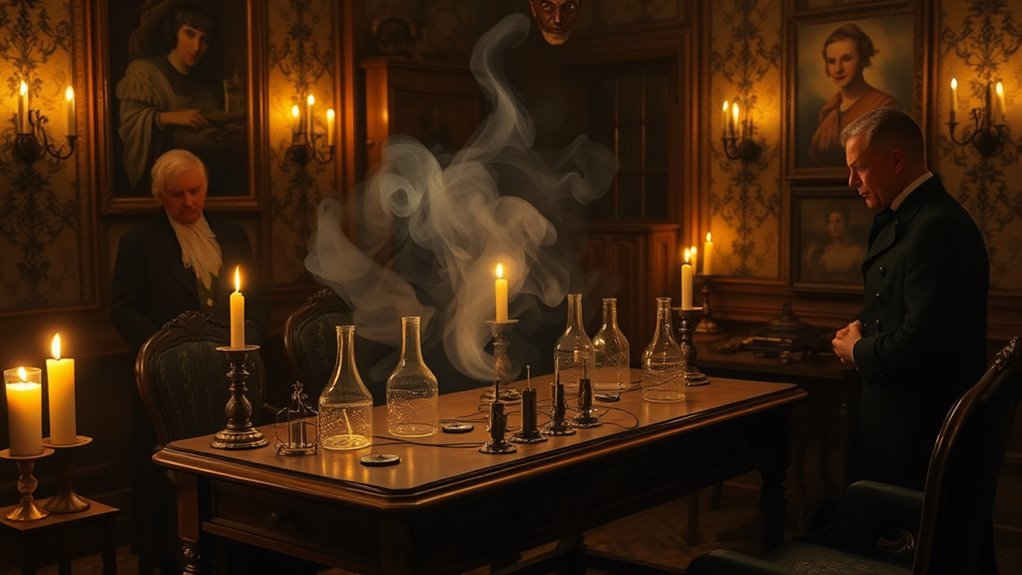
Ethical considerations are essential when conducting spirit investigations because they directly impact the trust and well-being of all involved. Respecting ethical boundaries ensures that you approach spirit communication responsibly, avoiding harm or manipulation. You must prioritize consent, making sure participants understand the purpose and potential risks of the experiment. Avoid exploiting spirits or participants for sensationalism; instead, foster an environment of honesty and respect. Maintaining confidentiality and protecting sensitive information is paramount, especially if personal details are shared during sessions. By adhering to these ethical principles, you build credibility and trust, which are fundamental for credible paranormal research. Upholding ethical boundaries also helps prevent psychological distress and preserves the integrity of your investigation.
Future Directions and Innovations in Paranormal Research
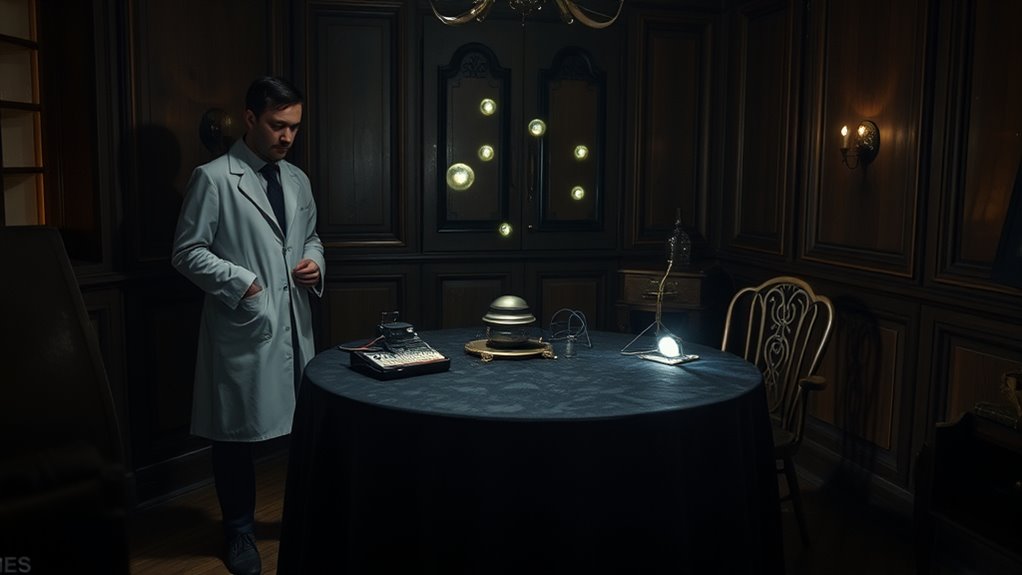
Advances in sensor technologies could revolutionize how you detect paranormal phenomena, making measurements more precise than ever before. Automation and sophisticated data analysis tools will help you identify patterns and separate genuine signals from noise. Together, these innovations have the potential to transform your approach to paranormal research and deepen your understanding of the unknown.
Enhanced Sensor Technologies
As technology continues to evolve, researchers are developing increasingly sophisticated sensor systems to detect subtle paranormal phenomena. These sensor advancements enable more precise measurements, capturing phenomena previously undetectable. You’ll see innovations like multi-sensor arrays that improve data integration, providing a holistic view of paranormal activity. Enhanced sensors include ultra-sensitive microphones, electromagnetic field detectors, and thermal cameras, all working together to identify anomalies. These tools help filter out background noise and false positives, sharpening the focus on genuine signals. By combining data from various sensors, researchers can better analyze patterns and correlations. This integration advances the reliability of paranormal investigations, opening new possibilities for understanding unseen forces. As sensor technology progresses, your capacity to explore the supernatural becomes increasingly precise and scientifically grounded.
Automation and Data Analysis
Building on the advancements in sensor technology, automation and sophisticated data analysis are transforming paranormal research into a more precise and efficient science. Automated systems can continuously monitor multiple variables, reducing human error and enabling real-time pattern detection. You can now leverage quantum entanglement principles to analyze connections between seemingly unrelated phenomena, offering new insights into spirit communication. Neural interfaces also play a role, allowing you to directly record neural activity during séances, potentially revealing subconscious cues or psychic signals. Advanced algorithms process vast datasets, identifying subtle correlations that might otherwise go unnoticed. This integration of automation, quantum physics, and neural technology accelerates your ability to test hypotheses rigorously, moving paranormal research closer to a scientific discipline grounded in verifiable data.
Frequently Asked Questions
Can Controlled Experiments Conclusively Prove the Existence of Spirits?
You wonder if controlled experiments can conclusively prove spirits’ existence. While quantitative analysis and strict experimental reproducibility can provide compelling evidence, they can’t definitively confirm spirits. Scientific methods aim for reliable, repeatable results, but the elusive nature of spirits means absolute proof remains out of reach. So, even with rigorous testing, you should remain cautious, understanding that science may never fully validate or invalidate the existence of spirits.
How Do Scientists Control for Subconscious Influence During Spirit Tests?
When it comes to controlling subconscious influence during spirit tests, it’s like trying to hit a moving target. You’d use double-blind procedures to guarantee neither participant nor researcher knows the conditions, minimizing bias. Placebo controls help distinguish genuine phenomena from expectations. By combining these methods, you can better keep subconscious influences in check, making your results more reliable and less swayed by personal beliefs or suggestions.
What Are the Limitations of Current Technology in Detecting Spirits?
You should understand that current technology faces sensor limitations that hinder spirits detection. These devices often can’t distinguish between natural environmental signals and potential paranormal activity, making data interpretation tricky. As a result, you might find it difficult to confidently identify spirits because the technology isn’t precise enough. Until sensor sensitivity improves and data analysis becomes more sophisticated, detecting spirits reliably remains a significant challenge.
Are There Any Standardized Protocols for Conducting Spirit Experiments?
You’ll find that standardized protocols for spirit experiments are limited, as the field lacks universally accepted procedures. To improve reliability, researchers should implement experimental controls, ensuring consistent conditions. While some attempt to develop standardized procedures, the subjective nature of spirits makes it challenging. Establishing clear guidelines could help, but currently, most investigations rely on individual methods rather than universally accepted protocols.
How Do Researchers Address Biases and Prior Beliefs in Paranormal Testing?
You can investigate how researchers address biases and prior beliefs by exploring methods like double-blind setups that reduce researcher bias. They also consider placebo effects, ensuring participants’ expectations don’t influence results. By implementing strict protocols, documenting procedures, and using statistical controls, researchers aim to minimize biases. This helps them objectively test paranormal claims, making their findings more reliable and helping you better understand the scientific approach to spirit experiments.
Conclusion
As you explore the world of spirit experiments, remember that science is only as good as the questions you ask and the methods you use. While technology and careful controls can shed light on unseen phenomena, skepticism remains your best friend. Don’t put all your eggs in one basket—stay open-minded yet cautious, because in this field, the truth often lies just beneath the surface, waiting for you to see beyond the smoke and mirrors.
